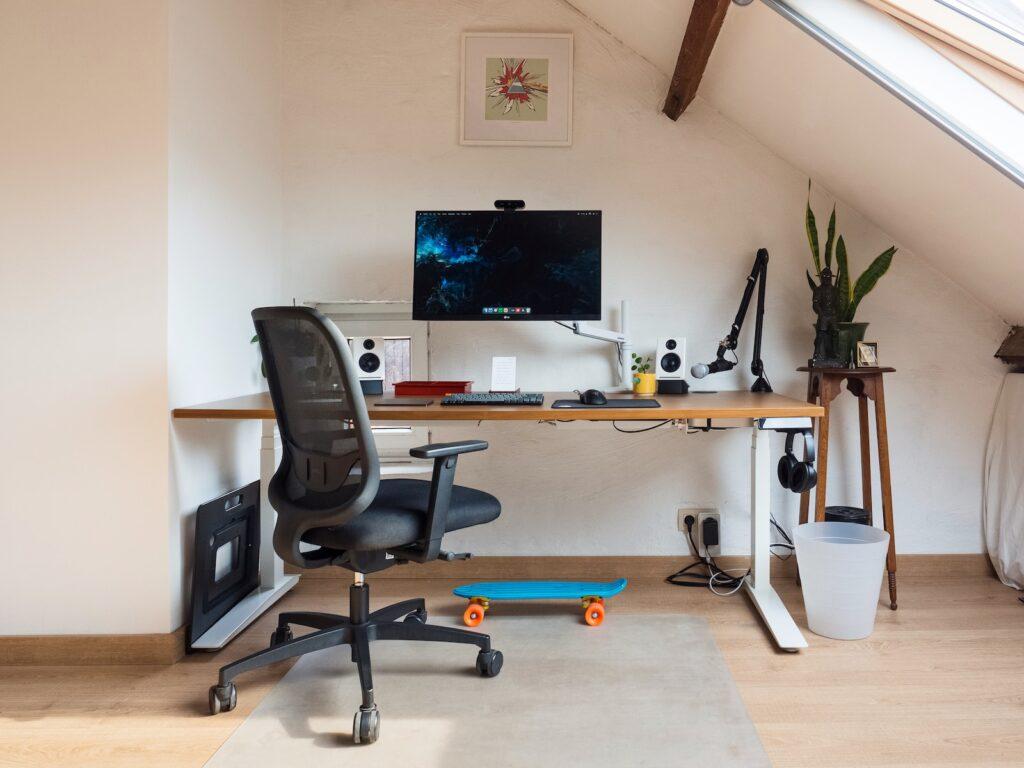Rated & Reviewed is reader-supported. When you buy through links on our site, we may earn an affiliate commission. Learn more.
Welcome to our guide on how to adjust your desk chair for optimal comfort. A well-adjusted chair plays a crucial role in maintaining good posture and preventing discomfort during long hours of work. In this article, we will walk you through the step-by-step process of adjusting your desk chair to achieve the perfect fit for your body. From positioning the armrests to adjusting the seat height and depth, we’ve got you covered. Let’s dive in and discover the secrets to an ergonomically friendly workspace.

Understanding Ergonomics
Before we delve into the specifics of chair adjustment, it’s important to understand the concept of ergonomics. Ergonomics is the science of designing and arranging objects to fit the human body’s natural abilities and limitations. When it comes to desk chairs, ergonomics is all about creating a comfortable and supportive seating environment that promotes good posture, reduces strain on the body, and enhances productivity. By adjusting your chair properly, you can significantly improve your overall well-being and work experience.
Setting Up the Chair
Let’s start by checking the components and adjustments of your desk chair. Most modern chairs offer various customization options to accommodate different body types and preferences. Begin by sitting in the chair with your feet flat on the floor and your back against the backrest. Follow these steps to achieve the ideal chair position:
- Adjusting Seat Height: Use the chair’s height adjustment lever to set the seat height so that your knees are at a 90-degree angle and your feet are comfortably resting on the floor. This position helps promote proper blood circulation and reduces strain on your legs.
- Setting Seat Depth and Angle: If your chair has adjustable seat depth, ensure there is a two-finger gap between the back of your knees and the edge of the seat. This allows for proper thigh support. Adjust the seat angle if possible to find a position that feels natural and comfortable for you.
- Positioning Lumbar Support: Many chairs offer lumbar support adjustments to maintain the natural curve of your lower back. Adjust the lumbar support mechanism or use a separate lumbar pillow to provide optimal support and alleviate lower back strain.
Configuring Armrests
Armrests play a crucial role in supporting your arms and shoulders, reducing strain, and promoting proper posture. Follow these steps to configure your armrests for optimal comfort:
- Adjusting Armrest Height: The armrests should be adjusted so that your forearms are parallel to the floor and your shoulders are relaxed. Raise or lower the armrests to achieve this position. If your chair allows, adjust the armrest width to ensure a comfortable fit for your arms.
- Positioning Armrests for Typing: Position the armrests close enough to your body that your elbows are slightly bent and your arms rest comfortably on the armrests while typing or using the mouse. This position helps prevent shoulder and neck tension.
- Preventing Wrist Strain: Ensure that your wrists remain in a neutral and straight position while using the keyboard and mouse. If the armrests are causing your wrists to bend unnaturally, consider lowering or removing them.
Tilt Mechanism and Recline
The tilt mechanism allows the backrest of your chair to recline, offering additional support and comfort. Follow these steps to configure the tilt mechanism:
- Understanding the Tilt Mechanism: Familiarize yourself with the different tilt options your chair provides. Some chairs offer a simple tilt function, while others have adjustable tilt tension and angle. Experiment with these settings to find the most comfortable position for you.
- Adjusting Tilt Tension: If your chair has adjustable tilt tension, customize it to suit your preference. The tension should be set so that you can recline comfortably while maintaining support. Avoid excessive resistance or complete freedom of movement.
- Using the Recline Function: Take advantage of the chair’s recline function during breaks or when you need to relax. However, avoid reclining too far back as it can strain your neck and lower back. Maintain a balanced and supported position even while reclining.
Optimizing Backrest Position
The backrest of your chair plays a vital role in supporting your spine and maintaining good posture. Follow these steps to optimize the backrest position:
- Adjusting Backrest Height: If your chair allows, adjust the backrest height to ensure it aligns with the natural curve of your spine, particularly targeting the lumbar region. Adequate lumbar support reduces the risk of lower back pain and promotes proper spinal alignment.
- Fine-tuning Backrest Angle: Experiment with different backrest angles to find the most comfortable position for you. Avoid reclining too far back or sitting upright without any support. Find a balance that provides both comfort and stability.
- Balanced Sitting Posture: While adjusting the backrest, ensure your shoulders are relaxed, and your spine remains upright. Avoid slouching or leaning forward excessively, as it can strain your back and neck. Maintaining a balanced sitting posture is essential for long-term comfort.
Positioning the Headrest
If your chair comes with a headrest, follow these guidelines to position it correctly:
- Adjusting Headrest Height: Position the headrest at a height that allows your head to rest comfortably against it without straining your neck or forcing your head forward. The headrest should support the natural curve of your neck and provide a comfortable resting position.
- Angling the Headrest: Some headrests allow you to adjust the angle for optimal support. Experiment with different angles to find the position that feels most comfortable and aligns with the natural curve of your neck.
Proper Arm and Leg Positioning
To maintain optimal comfort and reduce strain, consider the positioning of your arms and legs:
- Correct Arm Positioning: Ensure your arms are positioned at a comfortable height while typing or performing desk work. Adjust the height of your keyboard and mouse, if possible, to align with your armrests and provide a natural position for your forearms.
- Keyboard and Mouse Placement: Position your keyboard and mouse in a way that allows your wrists to remain straight and your arms relaxed. Avoid excessive reaching or bending of your wrists, as it can lead to discomfort and strain.
- Leg Position and Foot Support: Keep your feet flat on the floor or use a footrest if necessary. Adjust your chair height to ensure your knees are at a 90-degree angle and your thighs are parallel to the floor. This position helps promote proper blood circulation and reduces leg fatigue.
Additional Tips for Comfort
In addition to adjusting your chair, consider implementing these tips for added comfort:
- Using a Footrest: If your feet do not reach the floor comfortably, consider using a footrest to provide additional support and promote better leg circulation.
- Ergonomic Accessories: Explore the use of ergonomic accessories such as wrist rests, lumbar pillows, or seat cushions to further enhance your comfort and support.
- Taking Regular Breaks: Remember to take short breaks throughout your workday to stretch, walk around, and give your body a chance to relax and reset.
FAQs
How often should I adjust my desk chair?
It’s recommended to re-evaluate and readjust your desk chair every few months or whenever you experience discomfort or changes in your body’s needs.
Can I adjust my desk chair if it doesn’t have specific customization options?
Yes, even chairs without advanced customization can be adjusted to some extent. Experiment with pillows or cushions to provide additional support and comfort.
Are there any specific exercises or stretches I can do to complement chair adjustment?
Yes, incorporating regular stretches and exercises into your routine can help alleviate tension and promote better posture. Consult with a physical therapist or ergonomic specialist for personalized recommendations.
How can I ensure my chair adjustments are correct?
Listen to your body and make adjustments based on comfort. If you experience any pain or discomfort, consult with an ergonomic expert or healthcare professional for guidance.
Conclusion
Congratulations! You’ve learned how to adjust your desk chair for optimal comfort. By following the step-by-step instructions provided in this guide, you can create an ergonomically friendly workspace that promotes good posture, reduces strain, and enhances your overall well-being. Remember to regularly evaluate and readjust your chair to accommodate any changes in your body or workspace setup. Prioritize your comfort and make the necessary adjustments to create a productive and comfortable work environment. Happy sitting!
Amazon and the Amazon logo are trademarks of Amazon.com, Inc, or its affiliates.


